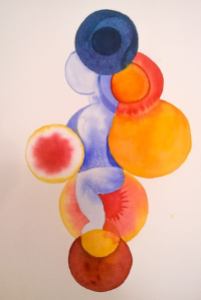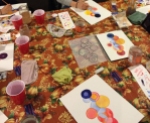It happens frequently; a blank stare, the wandering brush, a few extra dips in the water and a heavy sigh. The question is palpable. “What am I going to paint?” An artist doodles hopefully on scrap paper, she explores wet on wet techniques and brush strokes, the little experiments that emerge from free exploration bloom in beauty and richness. Then, as soon as her brush is placed on her “real” painting the fluidity and untethered joy disappear and everything tightens then muddies on the paper. Frustration ensues.
Frustration is part of the artistic process. Not just the artistic process, it is part of learning. It is an indication you are on the journey from here to the there you want to be. We should celebrate healthy frustration, it signals the verge of some new finding and an indication that we are engaged in deliberate practice. Each step we take to explore our frustration, we will learn. It is a beautiful thing.
While some freeze with frustration, others bloom. In workshops, the goal is to create just one pendant in three hours. I’ve had a couple people make as many as five that they love. Yes, one was a part-time artist and the other was an engineer with no painting experience. How do you make sense of that?
How do I? Mindset is 90% of everything. That’s how I make sense of it.
But mindset is a tricky beast. I can’t tell you to fix your mindset and you simply change on the spot. There is a lot of internal dialogue to struggle with and sometimes it’s downright stubborn and insidious. That damn voice wont stop telling me that I’m never going to paint another painting as good as…..fill in the blank. I know it isn’t helpful, and the voice should go away and I tell it to go away but the stupid voice is still there. Ugh.
And there is this: sometimes there is no voice. Just an indistinct discomfort in the pit of the stomach. That is a sneaky beast and potentially paralyzingly to creativity and inspiration.
Certain people are more comfortable handling discomfort and sneaky negativity. They come armed with coping mechanisms and inspiration to deal with it.
Here are a few to keep in mind at the next workshop or creative endeavor.
Ask Questions – Lots of Questions
The engineer that happily made five necklaces asked a ton of questions. She had no experience but she had endless curiosity. From asking about the nature of pigments to advice about composition she made use of my experience and got as much as should could out of it.
Simply asking “How did you do that?” can speed up inspiration when the answer starts to unfold. Or “I want it to look like this. How do I do that?” Can save you miles of doodling aimlessly. Ask the questions, even if they seem stupid. The next question will be even better.
Remember, from my perspective as a teacher, it is an honor to be asked. I love questions.

Bring Color Inspiration
Color triggers emotion. Consciously or unconsciously, we have strong opinions about color. You love them, you hate them, you want a room full of them or a room subtracted from them. A strong opinion creates fantastic art. Own your opinions with a full and fearless heart and embrace color.

Do you have a favorite color combination? Or hue? What about your favorite swimsuit, t-shirt or outfit? Match the colors of your favorite jewelry. Bring the colors your love, they will incite and inspire your creative process.
The colors we use in my workshop are the best, professional quality and I only use best paper for a reason. These color explode with intensity and vibrancy. This is no average color experience, take advantage of it.
Look Around & Bring Your Favorite Images
The natural world is the most amazing artist. Sunsets, ocean water, landscapes and other abstract work are all awesome sources of inspiration. Abstract work is naturally inspired by both the environment and emotion which are perfect fuel for inspiration. A flower, a tree, a stone and a texture that you find inherently beautiful can motivate your brush and vision. Bring them and study them. Surf the internet or take some photos on your phone.
Or use what you see at workshop, I have my own jewelry and paintings available to view. You can also check out some of the writing and paintings in my little free book, The Art Ritual.

Once you have a small collection of what you like, notice what you like and don’t like. Start answering the question, why do I like this photo, image or piece of art?
And remember…
It’s okay if a painting starts to look like something you have seen. Really, it is fine. This is part of exploring and finding your voice. It means you are defining what you like, developing taste and starting to form your artistic vision. Embrace this as part of your artistic awakening.
Invite Surprises
Keep the tension between what you think you will create and stay open to the surprise of what you will actually create. Dissonance between the two is natural and part of learning and creating. It is easy to cling to a vision and stubbornly insist the art in front of you doesn’t measure up. That mindset is easy to maintain. But often, it gets in the way of actually seeing the value and beauty of what you have created.
The truth is our imaginations are often much better than our skill set. Our imagination is what drives us to be better but also what drives us to be overly critical. Follow the process through and let the painting teach you something. Invite the surprises in your learning process. You may not measure up to your initial vision but what emerges may offer you more when it represents a small step or leap in the direction of your creative life.
A sense of possibility will unwrap a multitude of possibility.

Ready to Dive In?
Are you ready to test the theory and put this inspiration to the test? My next workshop is coming up soon.
Watercolor Necklace Workshop (Mimosas and Brunch) $39
Sunday, December 3rd from 9:30 am to 12:30
More information here.



 and join me:
and join me: 























You must be logged in to post a comment.